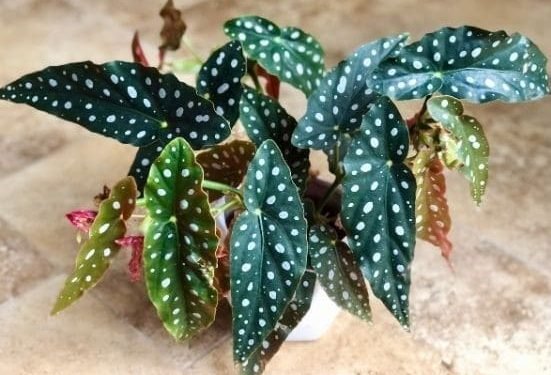Introduction
Plants are beneficial in keeping you happy and healthy because they are natural supporters of nature. Even most studies narrate that plants can keep your home free of harmful vibes and allow for prosperous well-being.
In this regard, Begonia Maculata Mature is a beautiful plant that can add some color to your home. The leaves of the plant are green and have either red or brown spots. Its flowers are white, and they have yellow centers.
You might wonder why this plant is so exciting and how you can keep it in your home. This is a beautiful and compelling indoor plant that you can quickly get from Plantale, and let welcome the green leaves with white dits to adore your living.
What is Begonia Maculata?
If you are looking for a plant that is easy to care for and will add a touch of elegance to your home, then begonia maculata is the plant for you. This beautiful plant is native to Brazil and has been a popular houseplant for centuries.
The Begonia Maculata is a perennial plant, meaning it will last many years with the proper care. It is known for its unique leaves, which are a deep green color with silver spots. The plant’s flowers are pink or white and bloom in the summer months. This plant can grow up to two feet tall and three feet wide, making it a perfect addition to any indoor space.
Interesting Facts About Begonia Maculata
Did you know that begonias are one of the oldest plants in the world? Fossils of begonias have been found that date back to the dinosaurs!
Spotted Leaves
Begonia maculata is a widespread species of begonia that is native to Brazil. The plant comes from the Latin word “maculatus,” which means “spotted.” It is also known as the spotted begonia or the tiger begonia.
Evergreen perennial
The Begonia maculata is an evergreen perennial that can grow up to 1 meter in height. Its leaves are large and oval-shaped, with distinctive silver spots.
Easy to care for
This begonia is easy to care for and is a popular houseplant. It does best in indirect sunlight and should be watered regularly. Begonias are toxic to cats and dogs, so keep this in mind if you have pets.
Where Does It Come From?
The begonia maculata is a popular houseplant and is often used as an ornamental plant in gardens. It is a member of the Begonia family, which includes over 1,500 species of plants. The family is named after Michel Bégon, a French governor of Santo Domingo who was an avid botanist.
This plant family is found in tropical and subtropical regions around the world. Moreover, this is a perennial plant, meaning it can live for more than two years. The plant reproduces by producing seeds that are contained in small, round fruits.
How do you care for it?
Begonia Maculata, also known as the Polka Dot Begonia, is a beautiful and relatively easy to care for plant. Here are some tips on how to keep your Begonia Maculata healthy and happy.
Light
Begonia Maculata does best in bright, indirect light. Too much direct sunlight can scorch the leaves, so if you live in a mainly sunny climate, it’s best to filter the light with a sheer curtain or place the plant in a north-facing window.
Water
Allow the top few inches of soil to dry before watering your Begonia Maculata. Be sure to empty any water that collects in the saucer under the pot, as begonias are susceptible to root rot.
Temperature
This plant prefers warm weather and should be kept in an environment with a temperature between 68-75 degrees Fahrenheit. If the temperature exceeds 75 degrees, the plant leaves will begin to curl. If the temperature falls below 68 degrees, the leaves will turn brown and drop off. The nighttime temperature needs to stay above 60 degrees for the plant to produce flowers.
Feed
To have a healthy and thriving begonia maculata plant, it is essential to understand its feed requirements. As a general rule, begonias require more nitrogen than phosphorus and potassium.
However, the specific nutrient requirements of begonia maculata may vary depending on the growth stage. For example, begonias require more nitrogen during the vegetative stage to promote leaf growth. Once the plant begins to flower, it will need more phosphorus to encourage blooming.
The best way to determine the specific feed requirements of your begonia maculata is to consult with a professional grower or horticulturist. They will be able to advise you on the best fertilizer for your particular plant.
Bottom Line
The Begonia Maculata Mature Plant is an attractive plant with many unique features. With its beautiful flowers and intriguing leaves, this plant can add a touch of elegance to any home. It is important to remember that the Begonia Maculata plant needs a lot of care and attention, but they are definitely worth the effort.
1- Plant dormancy in the perennial context
Available online 9 April 2007
https://www.sciencedirect.com/science/article/abs/pii/S1360138507000830
2- First Report of Myrothecium roridum Causing Myrothecium Leaf Spot on Dieffenbachia picta ‘Camilla’ in Taiwan
Published Online:8 Aug 2013
https://apsjournals.apsnet.org/doi/abs/10.1094/PDIS-02-13-0177-PDN
3- Soil Phosphorus
Available online 16 April 2008.
https://www.sciencedirect.com/science/article/abs/pii/S006521130860735X




